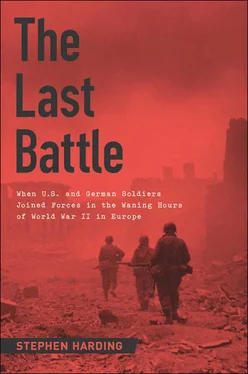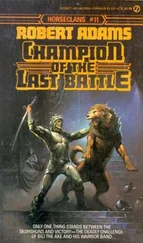37. Smyth, The Bounding Basque , 154–155.
38. Daladier, Prison Journal , 335.
1. World War II Soviet “fronts” were roughly equivalent to army groups in the U.S. Army. Made up of multiple field armies, each of which comprised several corps, the 3rd Ukrainian Front by April 1945 totaled some one million men.
2. In U.S. usage, numbered armies are identified by words, not numerals.
3. Seventh Army was under the command of Lieutenant General George S. Patton, who relinquished command to Patch following the island’s seizure.
4. For more details on Eisenhower’s overall plan for Austria and southern Germany, see MacDonald, European Theater of Operations , 436–438.
5. Patton was promoted to full general on April 14, 1945. Devers gained four-star rank on March 8, 1945.
6. The individual units assigned to each of Seventh Army’s three corps— the other two being VI and XV—changed fairly frequently, with divisions being moved between corps as the tactical situation demanded.
7. Panzer-grenadier units combined tanks, truck-borne infantry, and artillery, antitank, and engineer elements.
8. Details on von Hengl’s mission, force, and activities are drawn from his 1946 monograph Kampf um die Alpenfestung Nord , prepared as part of the U.S.-government-produced Foreign Military Studies, 1945–1954.
9. Grossdeutschland was the German army’s premier combat division (and not, as widely believed, a Waffen-SS organization). Von Hengl’s belief that elements of the division were present in Tyrol at this point in the war may not be accurate, in that most official histories (both German and American) indicate that Grossdeutschland ended the war in northern Germany. Of course, it is entirely possible that some members of the division had been sent to Austria under circumstances that are no longer clear.
10. Kampf um die Alpenfestung Nord , 2–3.
11. OKW is usually translated as High Command of the Armed Forces, and Führungsstab B was one of two operational headquarters under OKW.
12. In the event, those few units of the two larger organizations that did manage to make it into Tyrol didn’t get far enough east to be of any real help to von Hengl.
13. Born in 1901, Hans Buchner was a highly regarded German-born gebirgsjäger officer. After World War II he joined the West German Bundeswehr, eventually rising to the rank of general. From 1956 to 1959 he commanded the Bundeswehr’s 1st Gebirgsjäger Division.
14. Giehl was the commandant of the Heeresunteroffiziersschule für Gebirgsjäger in Wörgl.
15. Also referred to in some records as “Reserve Division Innsbruck.”
16. The source of the Inn River is in Switzerland, and it flows northeastward through Tyrol and into Germany.
17. See note 9 above. If these troops were not from Grossdeutschland, it is likely they were drawn from various Wehrmacht units that had retreated into Austria from Bavaria.
18. Kampf um die Alpenfestung Nord , 2–3.
19. Details on the formation, organization, and operations of the Austrian resistance are drawn primarily from Luza, The Resistance in Austria , and the Austrian Federal Press Service’s Resistance and Persecution in Austria, 1938–1945 .
20. In German, Provisorisches Österreichisches Nationalkomitee.
21. Established by presidential military order on June 13, 1942, the OSS was both an intelligence-collection and analysis agency and a covert-operations organization. Headed by World War I hero William J. Donovan, the OSS saw service in both the European and the Pacific theater.
22. “O5” was a clever rendering of the first letter of the German word for Austria, Österreich, which when typed without the umlaut is printed as “Oe.” Thus, the capital letter O followed by the number 5 (indicating the fifth letter of the alphabet, e ) equals Ö for Austria. The symbol was created by a young Austrian medical student, Jörg Unterreiner. Resistance members would daub the symbol in paint on the sides of buildings, on streetcars, and, if they were particularly brave (or foolhardy), on the sides of German military vehicles.
23. For two especially engrossing accounts of OSS operations in Austria, see Schwab, OSS Agents in Hitler’s Heartland , and O’Donnell, The Brenner Assignment .
24. Luza, The Resistance in Austria , 245–246.
25. Between 1935 and 1937, for example, the German-born socialist Waldemar von Knoeringen (1906–1971) established small anti-Nazi cells in Wörgl and several nearby towns.
26. The Feb. 22 attack and one the following day were part of the 15th Air Force’s contribution to Operation Clarion, a joint U.S.-British effort to completely paralyze the Third Reich’s already much-degraded rail and communications networks by specifically targeting smaller cities and towns that might not have been heavily attacked thus far. Several thousand aircraft participated, flying from bases in France, England, and Italy. For details, see Craven and Cate, Europe , 731–732.
27. Personalakten für Gangl, Josef .
28. Biographical information for Gangl is drawn primarily from his personalakten and from data provided by the Stadtarchiv Ludwigsburg in Germany and the Tiroler Landesarchiv in Innsbruck, Austria.
29. While details about Sepp Gangl’s siblings are sketchy, it appears that he had at least two brothers and one sister.
30. I have been unable to determine the name or gender of their second child.
31. A play on the German term blitzkrieg or “lightning war,” sitzkrieg literally means “sitting war.”
32. Taus, now Domažlice, is in the Plzen Region of the Czech Republic.
33. “Combined-arms,” in this context, means a coordinated and integrated operation by mutually supportive armor, infantry, and artillery units backed by tactical aircraft.
34. Werfer means “thrower,” and nebelwerfer is literally translated as “fog thrower.” The term originally was used to describe single-barrel, cannon-like weapons used to fire smoke or gas shells.
35. And the numbers were even more impressive with larger werfer units. According to Rocket Projectors in the Eastern Theater , a postwar history written as part of the U.S. government’s Foreign Military Studies series, in ten seconds a werfer regiment could fire 324 rockets, and a brigade 648.
36. Formally designated 15cm Panzerwerfer 42 auf Selbstfahrlafette Sd.Kfz.4/1, the Opel-built Maultier weighed just over nine tons, carried between twenty and forty werfer rounds, and had a top speed on paved roads of about twenty-five miles per hour.
Читать дальше












